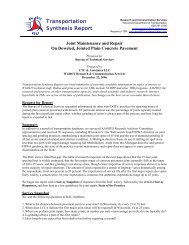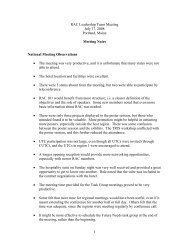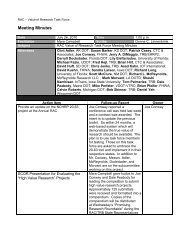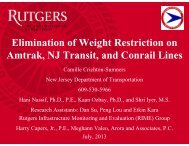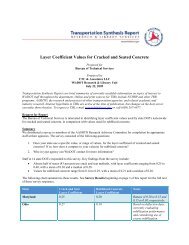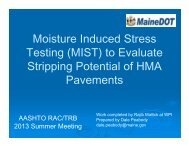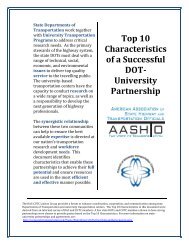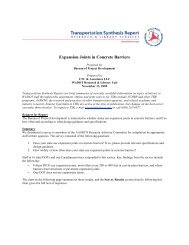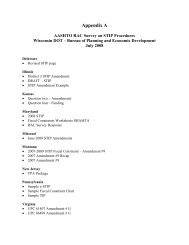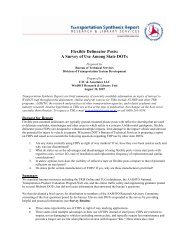PART IV: Summary of Comments - SCOR/RAC
PART IV: Summary of Comments - SCOR/RAC
PART IV: Summary of Comments - SCOR/RAC
You also want an ePaper? Increase the reach of your titles
YUMPU automatically turns print PDFs into web optimized ePapers that Google loves.
<strong>PART</strong> <strong>IV</strong>: <strong>Summary</strong> <strong>of</strong> <strong>Comments</strong>17-May-10Reviewer <strong>Comments</strong> Distribution <strong>of</strong> Ratings■ It has been my experience that horizontal curve transitions are not a safety issue.Other■ Topic area might be addressed using data from the SHRP 2 NDS in the future, but there is no duplication in the project.Item #79:B-05Solutions to Minimize the Impacts <strong>of</strong> Roadway De-IcingMaterials on Freshwater Systems(17)(46)NR 0 1 2 3 4 5<strong>SCOR</strong> 2 4 2 4 3 2<strong>RAC</strong> 1 6 6 6 13 12 5Standing Committee on Research■ The FHWA and NCHRP staff evaluation indicates this proposal mirrors research already undertaken and reported (2007NCHRP report 577). Unless the proposal is rewritten to build on this existing work or possibly field test and enhance thedecision making tool this research and expenditure will be mostly redundant.■ Existing work has already examined this area■ Work has already been done (NCHRP 577)■ There remain significant questions on sensitive organisms. Aquatic toxicity work should be done on a case by case basisconsidering specific aquatic conditions (e.g. sensitive frog populations in small drainages near highways).■ Appers to be largely duplication <strong>of</strong> existing work.■ Much <strong>of</strong> this work was evaluated under NCHRP Report 577 in chapter 3. I agree with Patricia Cazenas comment that theproposal should be rewritten to expand on the previous study focusing on application rates related to weather. A studyaiding the practitioner's ability to apply different chemicals or blends <strong>of</strong> chemicals in the most efficient manner dependenton the weather and functional class <strong>of</strong> highway would be more beneficial.■ As pointed out by FHWA in their comments, the author does not mention 2007 NCHRP report #577, "Guidelines for theSelection <strong>of</strong> Snow and Ice Control Materials to Mitigate Environmental Impacts". This seems like it may be a goodjumping <strong>of</strong>f point. If the author did not cite this document then he may not have been aware <strong>of</strong> the findings and shouldreview this research and possible revise the problem statement and goals. I think that this research could be beneficialnationwide, even here in AZ. Currently, ATRC has funded a small project to look at the application rates <strong>of</strong> winterchemical aditives and whatever resarch that comes out <strong>of</strong> B-05 could influence how and what we apply. If they revise theproblem statement and goals, I give them a 4, if not then it would be lower (3).■ This is an important issue in in many water supply areas.■ [Rating: 3] The problem statement needs to incorporate and complement the existing research that has been recentlycompleted in this area.Research Advisory Committee■ After review <strong>of</strong> the research problem statement, support <strong>of</strong> this project as written would not be in the best interest <strong>of</strong> thedept. There is no need for this research because as the problem statement indicates the ecological impacts to freshwatersystems are well documented in scientific literature. The $450,000 funding would be better spent on implementing bestpractices in winter maintenance as outlined in AASHTO North American Winter Scan. Furthermore, three years for aresearch period is too long particularly when winter snow and ice technology changes so rapidly. There are also severalflaws in the problem statement. They admit there are many chemical deicers such as Sodium Chloride, MagnesiumChloride, Calcium Chloride and others. To make anything meaningful they would have to study all <strong>of</strong> these. They alsosay, "will test the effects <strong>of</strong> the identifed treatments to narrow down possible materials... in minimizing impacts to targetsfreshwater sytesm and aquatic speicies." What about safety to the public during winter driving? What about theeconomic impacts? The problem statement then goes on to state that laboratory studies will be used. I do not believe labstudies can replicate the multiple variables <strong>of</strong> speed, traffic, ground conditions , slope, various applicaton rates, etc. Theoutcome <strong>of</strong> the project could easily be used against the department in court cases. If the project recommends a practicethe department can not abide by, ODOT runs the risk <strong>of</strong> going astray <strong>of</strong> the findings in a project supported by the<strong>IV</strong>-56



